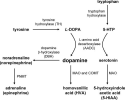no, both MAO-A and SERT variants with higher functioning are correlated with violence not the other way around(AFAIK)
That is incorrect.
If we look at what MAO-A actually does, it is an enzyme involved in breaking down monoamine neurochemicals.

Dopamine is initially broken down by MAO-A into DOPAC, which is subsequently methylated via catechol-O-methyltransferase to yield homovanillic acid (HVA).
Serotonin is broken down to 5-HIAA through MAO-A also.
Norepinephrine (noradrenaline) and Adrenaline are also metabolized by MAO-A and COMT to yield vanilylmandelic acid (VMA)

Hence, higher activity of these enzymes is associated with depression, flat mood, and lack of motivation. The reason is because high-activity variants of MAO-A/COMT lead to rapid breakdown of the neurotransmitters and predispose one to a low serotonin, low dopamine, low adrenaline state.
On the other hand, low-activity variants predispose one to a high dopamine, high adrenaline, high serotonin state. This is associated with aggression, violence, etc.
You can read this full review paper for more details:
The criminal gene: the link between MAOA and aggression (REVIEW)
Results
The low activity form of the MAOA gene (MAOA-L) has been linked to increased levels of aggression and violence. Data from a 2007 study suggests that MAOA-L individuals are hypersensitive, so are affected more by negative experiences (thus react more aggressively in defence) as opposed to being hyposensitive, and lacking emotion for harming others. Male members of a large Dutch kindred displaying abnormal violent behaviour were found to have low MAO-A activity linked to a deleterious point mutation in the 8th exon of the gene. The unaffected male members within the family did not carry this mutation. The first study that investigated behaviour in response to provocation showed that, overall, MAOA-L individuals showed higher levels of aggression than MAOA-H (high MAOA activity) subjects. There was also strong evidence for a gene-by-environment interaction as both groups showed similar low levels of aggression with low provocation, but MAOA-L individuals displayed significantly higher levels of aggression in a high provocation situation. A further gene-by-environment interaction was found in a long-term study performed on large number of children. Those with the MAOA-L genotype paired with maltreatment in childhood were correctly predicted to commit crime. Similar results are replicated in the majority of other related studies, but not all.
Go to:
Conclusions
We present mounting evidence that biological, environmental, and social factors are involved in criminal behaviour. Deficiencies in MAO-A activity have been identified in numerous studies to correlate positively with aggressive behaviour, but its influence may be moderated by environmental factors. Although further research into this aspect of neurocriminology is required, the findings highlight an ethical dilemma with regards to prosecuting criminals. Since individuals cannot be held accountable for their genes, should they be held responsible for their dispositions and resulting actions?



